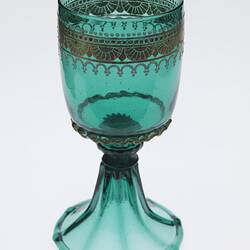Summary
Emerald green glass goblet with gilded decoration on the bowl, attributed to the Harrach glass factory, Neuwelt, northern Bohemia (now Harrachov in the Czech Republic), circa 1880.
Count Harrach of Neuwelt (Nový Svet, now Harrachov) presented the largest display of Bohemian glass at the Melbourne International Exhibition. Effusively described in the description of the Austro-Hungary Court, Harrach's display was awarded a First Order of Merit (gold medal).
The rapid development of innovation in glassware during the late nineteenth century meant that some styles of glass were being seen in Melbourne for the first time. One particular example of Harrach glassware was 'a specimen of granulated-gold green glass which was not in the Sydney Exhibition, but is, so to speak, the invention of yesterday'.
Glass workshops were established in Harrachov in 1712 by Elias Müller, who had gained permission from the then Count, Alois Raimund von Harrach. The Harrach family acquired the glass works in 1754, and the growth of the glass industry in the region is partly due to the long-standing reputation of the factory's output. Glass blanks manufactured at the Harrach factory were used by a number of the other major Bohemian glass manufacturers and designers in the late nineteenth century.
The Harrach glass works were privatised in 1993, and continue today under the name Sklarna Novosad and Syn (Novosad and Sons) Bohemia Harrachov.
Physical Description
Emerald green blown glass goblet, with gilt and painted decoration. Deep bowl on shouldered stem fluting to circular foot. Painted classical fan design in gilt with red, blue and white highlights around top of bowl. Twist around base of bowl, painted gold. No markings.
More Information
-
Collection Names
-
Collecting Areas
-
Acquisition Information
Cultural Gifts Donation from Dr Will Twycross, 23 Jan 2009
-
Acknowledgement
Donated through the Australian Government's Cultural Gifts Program
-
Manufacturer
Count Harrach, Austro-Hungarian Empire (Czechoslovakia), circa 1880
-
Place & Date Exhibited
Royal Exhibition Building (REB), Nicholson Street, Carlton, Greater Melbourne, Victoria, Australia, 1880-1881
-
Collector
Mr John Twycross, Elsternwick, Greater Melbourne, Victoria, Australia, 1881
-
Classification
Royal exhibition building, International exhibitions, Exhibition heritage
-
Category
-
Discipline
-
Type of item
-
Overall Dimensions
75 mm (Width), 163 mm (Height)
-
References
[Link 1] 'Austria', Argus (Exhibition Supplement), Monday, 11 October 1880, p.21 Petrova, Sylva, and Olivie, Jean Luc (ed), Bohemian Glass, 1400-1989, Harry N. Abrams Inc, New York, 1990.
-
Keywords
Decorative Arts, Exhibitions: Melbourne International, 1880-1881, Glass, Royal Exhibition Building




